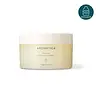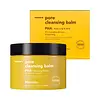What's inside
What's inside
 Key Ingredients
Key Ingredients

 Benefits
Benefits

 Concerns
Concerns

 Ingredients Side-by-side
Ingredients Side-by-side

Tocopherol
AntioxidantPrunus Armeniaca Kernel Oil
MaskingViola Odorata Oil
MaskingSorbitan Olivate
EmulsifyingOrbignya Oleifera Seed Oil
EmollientCitrus Aurantifolia Oil
CleansingPolyglyceryl-3 Caprate
EmulsifyingSorbitan Palmitate
EmulsifyingCitrus Aurantium Dulcis Peel Oil
MaskingEuphorbia Cerifera Cera
AstringentPelargonium Graveolens Oil
MaskingCedrus Atlantica Bark Oil
MaskingCetyl Palmitate
EmollientHelianthus Annuus Seed Oil
EmollientGeraniol
PerfumingPolyethylene
AbrasiveSorbeth-30 Tetraoleate
EmulsifyingPolyglyceryl-10 Oleate
Skin ConditioningBenzyl Benzoate
AntimicrobialPolyglyceryl-2 Sesquioleate
EmulsifyingCitronellol
PerfumingLimonene
PerfumingHydrogenated Vegetable Oil
EmollientLinalool
PerfumingAniba Rosodora Wood Oil
AstringentCitrus Aurantium Bergamia Fruit Oil
MaskingTocopherol, Prunus Armeniaca Kernel Oil, Viola Odorata Oil, Sorbitan Olivate, Orbignya Oleifera Seed Oil, Citrus Aurantifolia Oil, Polyglyceryl-3 Caprate, Sorbitan Palmitate, Citrus Aurantium Dulcis Peel Oil, Euphorbia Cerifera Cera, Pelargonium Graveolens Oil, Cedrus Atlantica Bark Oil, Cetyl Palmitate, Helianthus Annuus Seed Oil, Geraniol, Polyethylene, Sorbeth-30 Tetraoleate, Polyglyceryl-10 Oleate, Benzyl Benzoate, Polyglyceryl-2 Sesquioleate, Citronellol, Limonene, Hydrogenated Vegetable Oil, Linalool, Aniba Rosodora Wood Oil, Citrus Aurantium Bergamia Fruit Oil
Ethylhexyl Palmitate
EmollientCetyl Ethylhexanoate
EmollientSorbeth-30 Tetraoleate
EmulsifyingPolyethylene
AbrasiveHelianthus Annuus Seed Oil
EmollientC13-15 Alkane
SolventTrihydroxystearin
Skin ConditioningCitrus Aurantium Dulcis Peel Oil
MaskingLavandula Angustifolia Oil
MaskingTocopherol
AntioxidantCitrus Aurantium Bergamia Fruit Oil
MaskingCamellia Japonica Seed Oil
EmollientOenothera Biennis Oil
EmollientOlea Europaea Fruit Oil
MaskingPrunus Armeniaca Kernel Oil
MaskingSimmondsia Chinensis Seed Oil
EmollientGluconolactone
Skin ConditioningEthylhexyl Palmitate, Cetyl Ethylhexanoate, Sorbeth-30 Tetraoleate, Polyethylene, Helianthus Annuus Seed Oil, C13-15 Alkane, Trihydroxystearin, Citrus Aurantium Dulcis Peel Oil, Lavandula Angustifolia Oil, Tocopherol, Citrus Aurantium Bergamia Fruit Oil, Camellia Japonica Seed Oil, Oenothera Biennis Oil, Olea Europaea Fruit Oil, Prunus Armeniaca Kernel Oil, Simmondsia Chinensis Seed Oil, Gluconolactone
 Reviews
Reviews

Ingredients Explained
These ingredients are found in both products.
Ingredients higher up in an ingredient list are typically present in a larger amount.
Citrus Aurantium Bergamia Fruit Oil is the oil from the bergamot orange. It is native to Italy.
This ingredient is used to add fragrance to products. It contains limonene, linalool, and linalyl acetate.
The term 'fragrance' is not regulated in many countries. In many cases, it is up to the brand to define this term. For instance, many brands choose to label themselves as "fragrance-free" because they are not using synthetic fragrances. However, their products may still contain ingredients such as essential oils that are considered a fragrance.
When used topically, Citrus Aurantium Bergamia Fruit Oil is a photosensitizer due to its furanocoumarins. Photosensitizers make the skin and eyes much more sensitive to sunlight. Photosensitizers are linked to skin cancer.
However, more cosmetics using Citrus Aurantium Bergamia Fruit Oil are removing the furanocoumarins.
Bergamot oil was also found to have anti-inflammatory, antibacterial and antifungal properties.
Learn more about Citrus Aurantium Bergamia Fruit OilCitrus Aurantium Dulcis Peel Oil is oil from the peel of an orange fruit.
Limonene and linalool make up the majority of oils from citrus peels. Limonene has a "citrus" fragrance. Citrus peels also contain flavonoids, which have anti-inflammatory properties.
Citrus peel is also a rich source of flavonoids. Flavonoids are natural antioxidants and help protect your skin against damage. Flavonoids are a group of compounds naturally found in vegetables and fruits.
The term 'fragrance' is not regulated in many countries. In many cases, it is up to the brand to define this term. For instance, many brands choose to label themselves as "fragrance-free" because they are not using synthetic fragrances. However, their products may still contain ingredients such as essential oils that are considered a fragrance.
Learn more about Citrus Aurantium Dulcis Peel OilHelianthus Annuus Seed Oil is the oil derived from the seeds of a Sunflower. Sunflower seed oil is non-fragrant. It is an emollient, meaning it helps to soften the skin.
Sunflower seed oil contains many fatty acids. The fatty acids found in sunflower seeds include (from highest amount to least): linoleic acid, myristic acid, palmitic acid, stearic acid, arachidic acid, oleic acid, and linolenic acid.
These fatty acids help the skin create ceramides. Ceramides play a role in repairing the skin barrier.
Helianthus Annuus Seed Oil helps moisturize the skin. This in turn helps the skin look more rejuvenated and smoother.
Sunflowers are rich in vitamin E.
Historians believe Indigenous cultures of North America domesticated sunflowers before corn. Thus they relied on sunflower oil for a variety of uses. One such use is moisturizing skin and hair.
Sunflower seed oil may not be fungal acne safe. We recommend speaking with a professional if you have any concerns.
Learn more about Helianthus Annuus Seed OilPolyethylene is a synthetic ingredient that helps the skin retain moisture. It is a polymer.
It is also typically used within product formulations to help bind solid ingredients together and thicken oil-based ingredients. When added to balms and emulsions, it helps increase the melting point temperature.
This ingredient is the oil from the apricot.
Apricot Kernel Oil is an emollient and helps soften skin. This is due to its fatty acid components. Some of these fatty acids include linoleic and oleic acid.
This ingredient also has antioxidant properties from Vitamins A, C, and E. Antioxidants help fight free-radicals. Free-radicals are molecules that may damage your skin cells. Besides being antioxidants, these vitamins provide plenty of skin benefits as well.
Learn more about Prunus Armeniaca Kernel OilSorbeth-30 Tetraoleate is a surfactant and emulsifier.
This ingredient is a tetraester from oleic acid and polyethylene glycol ether of sorbitol.
As an emulsifier, it helps ingredients such as oil and water mix together. This allows the dirt and oils in your skin to be washed away.
One study found pumpkin oil containing Sorbeth-30 Tetraoleate helped hydrate the skin and did not cause any irritation.
Learn more about Sorbeth-30 TetraoleateTocopherol (also known as Vitamin E) is a common antioxidant used to help protect the skin from free-radicals and strengthen the skin barrier. It's also fat soluble - this means our skin is great at absorbing it.
Vitamin E also helps keep your natural skin lipids healthy. Your lipid skin barrier naturally consists of lipids, ceramides, and fatty acids. Vitamin E offers extra protection for your skin’s lipid barrier, keeping your skin healthy and nourished.
Another benefit is a bit of UV protection. Vitamin E helps reduce the damage caused by UVB rays. (It should not replace your sunscreen). Combining it with Vitamin C can decrease sunburned cells and hyperpigmentation after UV exposure.
You might have noticed Vitamin E + C often paired together. This is because it is great at stabilizing Vitamin C. Using the two together helps increase the effectiveness of both ingredients.
There are often claims that Vitamin E can reduce/prevent scarring, but these claims haven't been confirmed by scientific research.
Learn more about Tocopherol